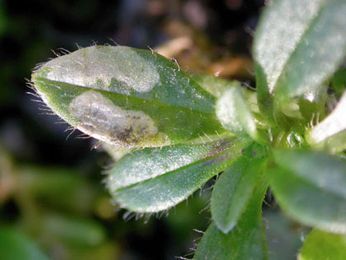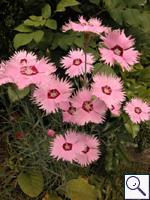|
||||||
|
DIANTHUS. Pinks. [Caryophyllaceae] |
|
|
Fifteen species and hybrids of Dianthus are recorded in Britain. These include the native Cheddar Pink (D. gratianopolitanus), Deptford Pink (D. armeria) and Maiden Pink (D. deltoides) and the introoduced Clove Pink (D. caryophyllus). Deptford Pink (D. armeria) and Cheddar Pink (D. gratianopolitanus) are protected under Schedule 8 of the Wildlife and Countryside Act, 1981. Four British miners are recorded on Dianthus. The agromyzids Liriomyza huidobrensis and Liriomyza trifolii, pest species of ornamental and vegetable crops occasionally intercepted at UK points of entry, have been recorded on Dianthus. Both species have been found under glass in England and Wales. All populations have been and continue to be eradicated. See also Liriomyza species in Glasshouses and/or Quarantine Interceptions. Although previously recorded as a miner in stems Dianthus, Botanophila fugax is a common saprophagous species, the larvae normally feeding in the soil (G.C.D. Griffiths, pers. comm.). No non-Diptera miners are recorded on Dianthus in Britain. A key to the European miners recorded on Dianthus is provided in Bladmineerders van Europa. |
|
Key for the identification of the known mines of British |
1a > Leaf-miner |
1b > Leaf and stem miner |
2 > Leaf-miner: A white linear-blotch mine, the linear section sometimes not detectable as it becomes enveloped in later blotch (Spencer, 1976: 162-3, figs 296-7). Upper-surface, less often lower-surface, corridor, followed, and often overrun, by a large blotch. Even when the corridor is overun, it usually remains recognisable in the frass pattern. The mine looks whitish in the field. The blotch does not contain much frass, in the form of small black grains, dispersed and stuck to the floor of the mine. Feeding punctures upper-surface (always?). Pupation outside the mine. A common miner, forming a white linear blotch mine (the blotch may obscure the linear portion of the mine) in both native and garden plants.The mine is also illustrated in the Encyclopedia of Life. |
|
Amauromyza flavifrons (Meigen, 1830) [Diptera: Agromyzidae]. |
3a > Leaf and Stem-miner: Mine always arising from the leaf base or ending in it, because the larva mines and changes leaves. Mine often broad, irregular corridor like, often touching the midrib. At first corridor often entirely without frass, later in the spring the mines are often less deep, containing thick, irregularly deposited frass lumps. |
|
Delia cardui (Meigen, 1826) [Diptera: Anthomyiidae]. |
3b > Leaf-miner: The mine starts as a long, narrow, winding corridor running towards the midrib, widening to a blotch. Usually upper-surface, but in small leaves also full-depth parts may occur. The blotch has broad lobes; in their ends most frass is accumulated in the form of green patches or clouds. Sometimes several larvae share mine. Pupation usually in the soil, less often in the leaf (and then generally not in the mine itself but in a small separated mine, that may even be made in the petiole). |
 Mine of Scaptomyza graminum on Cerastium glomeratum Image: © Jean-Yves Baugnée (Bladmineerders van Europa) |
|
Scaptomyza graminum (Fallén, 1823) [Diptera: Drosophilidae]. |
3c > Leaf and stem miner: Eggs are scattered individually over the leaf upper surface; they are only loosely attached to the plant. The egg shell has a honeycomb structure. The larva begins with first mining one of the top leaves completely out. Next the larva moves down to another leaf, by way of a tunnel made in the stem. In this way several leaves are mined out, completely and full depth. In the attacked part of the plant the stem has become translucent; the damage causes the plant tip to wilt. In the first mines almost no frass is to be found, further down it is deposited in coarse grains. Pupation generally outside the mine (Miles, 1953). |
|
Delia echinata (Seguy, 1923) [Diptera: Anthomyiidae]. |
| Last updated 03-Jul-2019 Brian Pitkin | ||

